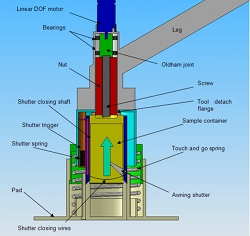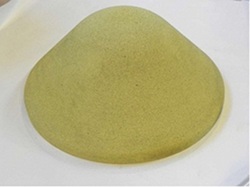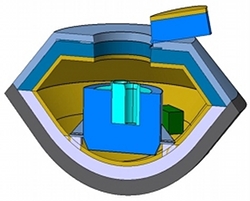Spacecraft
The concept of the MarcoPolo-R mission builds on the ongoing Phase-A system study. This study, led by ESA/ESTEC and involving industrial teams, has derived a feasible mission profile, fulfilling the science requirements, focusing on the primary goal to return a sample from the primitive asteroid 2008 EV5, a 400-m-diameter body. The system prime contractors Astrium and Thales Alenia Space are designing the space segment to derive the most cost-efficient mission possible, making as much use as possible of existing and low-cost technologies with acceptable risk levels.
The key sample return capabilities are the descent and touchdown system, the sampling mechanism, and the re-entry capsule. For those, a number of specific activities were completed or are ongoing; the results feed into the spacecraft design. ESA/ESOC is in charge of deriving a concept for the flight dynamics, mission operations and ground segment while ESA/ESAC is in charge of the science ground segment.
This low delta-V mission launches in December 2022 or December 2023 (with a backup in December 2024) and makes use of the SMART-1 electric propulsion engine and an Earth fly-by to reach the asteroid. The overall mission duration is 4.5 years - from launch to return to Earth. Six months are dedicated to in situ global and local characterization of the asteroid and sampling operations (e.g. rehearsals, three sampling attempts, etc.).
 |
 |
|
New technology is being developed to collect a sample from 2008 EV5. MarcoPolo-R will bring a sample of about 100 g of asteroid back to Earth for examination. A sampling tool concept is shown on the left (Credit: TAS), with another concept shown on the right (Credit: Astrium). |
|
The sampling operations build on a 'touch-and-go' approach which minimises the interaction of the spacecraft with the asteroid surface. The descent and touchdown follows a safe approach relying on robust navigation sensors (navigation camera and planetary altimeter) and a multi-function touchdown and sample transfer boom. Various sampling mechanism are being designed, breadboarded and will be tested on parabolic flights. The re-entry capsule is fully passive (i.e. no parachutes) and makes use of flight-proven technologies such as heat flux ablative material abd shock-absorbing structures.
 |
 |
|
Left: Asteroid descent simulation test bench. Credit: GMV/INTA. Right: Microgravity-simulated touchdown/landing tests in the DLR LAMA facility. Credit: DLR. |
|
 |
 |
 |
|
Asteroid surface simulation for navigation purposes. Credit: GMV |
Re-entry capsule stability tests. Credit: ESA |
Navigation camera breadboard. Credit: Astrium. |
|
|
 |
|
Left: Ablative material tests in arc jets. Credit: ESA. Right: Heat shield breadboard for Marco Polo (a mission that was studied by ESA and industry between 2007 and 2010.) Credit: ESA |
|
 |
|
A spacecraft concept from an early study phase (internal phase 0, Concurrent Design Facility concept. Credit: ESA |
The 'classic' service module would consist of all the subsystems necessary to support launch, interplanetary transfer, asteroid proximity operations (including remote sensing of the asteroid and sampling) and return to Earth. The service module includes a minimal communications subsystem consisting of fixed High- and Low-Gain Antennas, thanks to the very low distances to Earth during the mission. The power subsystem will consist of a 15-square-metre solar array and lithium ion batteries. The same type of plasma propulsion system as used on SMART-1 is used for the transfer to and from the asteroid and mono-propellant is used for asteroid proximity operations. The features of the target asteroid are such that it is almost always at a constant distance from the Sun of approximately 1 AU, similar to Earth, making the thermal subsystem design very simple.
Payload
As the main goal of the mission is to return a sample to Earth, the instrumentation on board the spacecraft is reduced to a minimum and relies mainly on proven technology. The following payload was selected by the Science Programme Committee to be part of the study phase, at the meeting of February 2013.
| MarcoPolo-R payload (study phase) | |
| THERMAP | A mid-infrared spectro-imager |
| MaRIS | MarcoPolo-R imaging spectrometer (visible and near-infrared) |
| RSE | MarcoPolo-R Radio Science Experiment |
| VESPA-VISTA2 | Very Essential Surface Package for Asteroid (VISTA2 sensor only) |
| CuC | Close-up Camera for MarcoPolo-R |
| MaNAC | MarcoPolo-R Narrow Angle Camera |
In accordance with the requirements for an M-class mission, this instrumentation is based on technologies that are in existence or under development.
Earth re-entry capsule
 |
|
Earth re-entry capsule, from an early study phase (internal phase 0, Concurrent Design Facility concept). Credit. ESA |
The proposed design for the MarcoPolo-R Earth re-entry capsule (ERC) is derived from a parachute-less design, to keep it simple and cost-efficient, making use of proven crushable structure technologies, as used in the motor, military or aircraft industry. The design of the ERC is optimised to meet MarcoPolo-R mission needs, which are much less demanding than the Mars sample return mission, while preserving its reliability. The ERC has an external shape similar to the capsule of the Hayabusa mission (but further activities are investigating dynamic stability to confirm the current design choice), and consists of a core structure and the crushable foam, the thermal protection system for the re-entry, and the sample container filled with the valuable asteroid sample.

